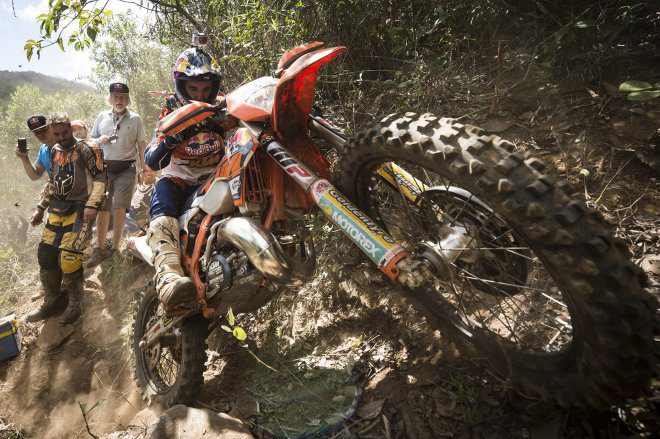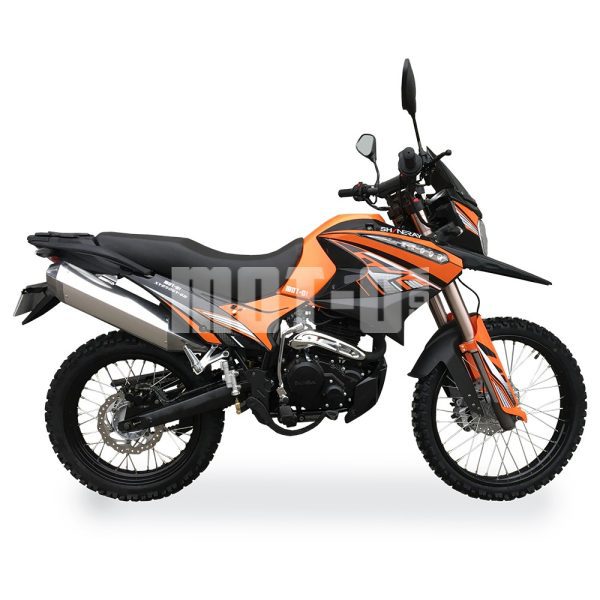
Comparative test: Hard enduro 250 2T
Husqvarna was supposed to join the test, but look at the fraction, in Motor Jet this time we were disappointed by the words: “Unfortunately, there is nowhere to get the 250 WR 2011, because they have long been sold out. We'll have to wait until June when WR 2012 arrives! “Well, reading three bikes is interesting, not least because it would be worth comparing KTM and Husaberg, which have almost the same engine, frame and brakes, the biggest difference is in the plastic or everything that is screwed on. Frame. We boarded the Spanish Gas Gas for the first time, which is a worthy competitor in this class and has revived the Austrian-Swedish fight so well.
Gas Gas is not known in Slovenia as it deserves, it is even more famous for its experienced motorcycles, where they are one of the main participants. The closest retailer is in Graz, Austria (www.gasgas.at) from where they also cover our tiny market. Over the past two years, the bike has undergone so many overhauls that it can be said to be as modern as the KTM. In the test, we rode it without an electric starter, but from this year it is also available at an additional cost on this matador and joined KTM and Husaberg with the "magic button". Design Gas Gas follows trendy teams with clean lines and aggressive graphics.
As with KTM, you also get it in a slightly updated version of Six-days. Thus, all three are separated from each other from afar and can in no way be confused with each other. Gasgas is red with a touch of white, Husaberg blue-yellow and of course KTM orange. KTM and Gas Gas have transparent fuel tanks, allowing you to quickly monitor fuel levels, while in Husaberg you have to work a little bit to figure out how long you can drive before you need to refuel. All three are well equipped for off-road driving and you can easily drive straight from the sedan to the race. Suspension KTM and Husaberg "home", ie. WP brand, telescopes facing forward, shock absorber at the rear, mounted directly on the swingarm (PDS system). The only difference is that Husaberg has a more expensive version of the front suspension, since the fork is closed (cartridge). In Gas Gas, however, the unevenness is mitigated by Sachs. The suspension is adjustable, too, but the forks just don't match what the competition is offering. They lack fine tuning and more progressive performance. Well, on the other hand, the rear is much better sprung and offers incredibly good traction.
The Gasgas suspension and frame combination delivers pleasing rear-end handling and aggressive, and above all, reliable, wide-open-throttle acceleration. However, somewhat disappointing large turning radius. The KTM suspension is kind of the sweet spot, nothing fails, but it still can't compete with the Husaberg, which is an incredible combination of lightness and cornering precision. You could say that the KTM is cornering well and the Husaberg is excellent. It goes through like a hot knife through butter, admiring the driver's surgical precision and rewarding him with lightning-fast responsiveness. Whoever can keep up Husaberg's pace, which takes more than the other two, also rewards him with good track times. The Husaberg pays for this with slightly less stability on fast flats with lots of bumps (smaller rocks, bigger rocks, or whatever), but this can be fixed by setting an "offset" on the axle where the crosses mount, hold the front fork. The driver's seat is well thought out, but on the KTM it's still slightly better. The Husaberg runs a little more compact, shorter if you like, while the KTM is best for riders of all sizes.
Movement on both bikes is unobstructed, the boots don't get stuck in the edges of the plastic, the seats are good (the KTM is slightly longer and more comfortable) and both have a comfortable under-wing reinforcement that you can grab the bike and lift it up while climbing. Here we can also praise Gas Gas, as they paid attention to detail, as well as details that make the driver's job easier. The only downside to this is that you will stain your gloves with dirt adhering to the inside of the mudguard as well as the grip. In the ergonomics chapter, it was only slightly disturbed by Gas Gas, as the side plastic inserts on the fuel tank that protect the left and right radiators are too wide and spread the knees, which is annoying when cornering. We would also like a taller seat that is 4 centimeters lower than the other two, and therefore a slightly more relaxed seat. On the other hand, Gas Gas is great for those who are a little shorter, or for those who like to race through difficult terrain, where they often have to help themselves with their feet. In Gas Gas, the height of the seat makes it almost impossible for a driver to step into an empty space. Perhaps this is why we experience the slight aftertaste after the test with which Gas Gas is so strongly associated.
We were impressed with the performance of the Husaberg engine, it is explosive or, if the driver so desires, quiet. KTM is a little behind here, and the softest character is the Gas Gas, which is impressive in the low rev range but loses a little in the high range compared to its competitors. However, because of this, the Spanish engine is very enjoyable to learn off-road driving skills. Exactly the same story with the brakes and their action. By no means can it be argued that any of these three brakes are bad, they are all very good, only in Husaberg they are really excellent, which is otherwise the case with the top motorcycle equipment package. This one is made to such a high standard that you can take it to a world title race without resorting to extra equipment.
Because of all of the above, the price is higher, but this is the only area where Husaberg loses a bit, even though he is the clear winner. The KTM is a middle ground enduro, okay, but the Husaberg beats it in some places. Gas Gas ranks third, is the winner if the main criterion is money, otherwise it lacks sharpness in the fight against competitors. Considering that he doesn't have a serious representative with us, we are also a little concerned about the supply of spare parts. The other two do it, and if we look at the hardly worth mentioning maintenance costs, they have a big advantage here.
If you're smelling the burnt mixture and are looking for a lightweight, maintenance-free bike and your favorite ride is technical terrain, each of these three has everything you need.
Petr Kavcic, photo: Zeljko Puschenik (Motopuls)
Face to face: Matevj Hribar
What amazes me the most is that stallions from the same barn, Husaberg and KTM, are so different. No, the TE 250 is not just an EXC 250 with yellow and blue plastic, but the feel of the first Berg two-stroke is completely different. It's sharper, more aggressive, even more agile than its orange cousin. As for the Gas Gas, I was expecting it to be bigger, well, different, or half-finished, but in fact it is fully competitive, only slightly stronger vibrations and a smaller steering angle bothered me. Not to mention the financial side of the story, my order is: Husaberg, KTM, Gas Gas.
Gas Gas EC 250
Test car price: € 7.495.
Technical information
Engine: single-cylinder, two-stroke, liquid-cooled, 249cc, Keihin PWK 3S AG carburetor, exhaust valve.
Maximum power: for example
Maximum torque: for example
Transmission: 6-speed, chain.
Frame: tubular chrome-molybdenum, auxiliary frame in aluminum.
Brakes: front disc? 260mm, rear coil? 220.
Suspension: Front adjustable inverted telescopic fork
Saxon? 48, rear adjustable single Sachs shock.
Gume: 90/90-21, 140/80-18.
Seat height from the ground: 940 mm.
Fuel tank: 9 l.
Wheelbase: 1.475 mm.
Weight without fuel: 101 kg.
Agent: www.gasgas.at
We praise:
- a light weight
- stability
- flexible, unpretentious engine
- price
We scold
- without a representative in Slovenia
- front suspension
- large riding circle
KTM EXC
Test car price: € 7.790.
Technical information
Engine: single-cylinder, two-stroke, liquid-cooled, 249 cm3,
Keihin PWK 36S AG carburetor, exhaust valve.
Maximum power: for example
Maximum torque: for example
Transmission: 6-speed, chain.
Frame: tubular chrome-molybdenum, auxiliary frame in aluminum.
Brakes: front disc? 260mm, rear coil? 220.
Suspension: Front adjustable inverted telescopic fork
WP? 48, rear adjustable single damper WP PDS.
Gume: 90/90-21, 140/80-18.
Seat height from the ground: 985 mm.
Fuel tank: 9 l.
Wheelbase: 1.475 mm.
Weight without fuel: 103 kg.
Representative: Axle, Koper, 05/663 23 66, www.axle.si, Moto Center Laba, Litija - 01/899 52 02, Maribor - 0599 54 545,
www.motocenterlaba.com
We praise
- versatility
- adroitness
- ergonomics
- engine
We scold
- more demanding to drive
- accessories price
Husaberg TE 250
Test car price: € 7.990.
Technical information
Engine: single-cylinder, two-stroke, liquid-cooled, 249 cm3,
Keihin PWK 36S AG carburetor, exhaust valve.
Maximum power: for example
Maximum torque: for example
Transmission: 6-speed, chain.
Frame: tubular chrome-molybdenum, auxiliary frame in aluminum.
Brakes: front disc? 260mm, rear coil? 220.
Suspension: Front adjustable inverted telescopic fork
WP? 48, rear adjustable single damper WP PDS.
Gume: 90/90-21, 140/80-18.
Seat height from the ground: 985 mm.
Fuel tank: 9 l.
Wheelbase: 1.475 mm.
Weight without fuel: 102 kg.
Representative: Axle, Koper, 05/663 23 66, www.husaberg.si
We praise:
- exceptional cornering accuracy
- adroitness
- ergonomics
- quality components
- powerful and lively engine
- brakes
We scold:
- for beginners a slightly (too) aggressive engine
- stability at high speeds with the basic setting of the spider offset
- price and price of accessories

